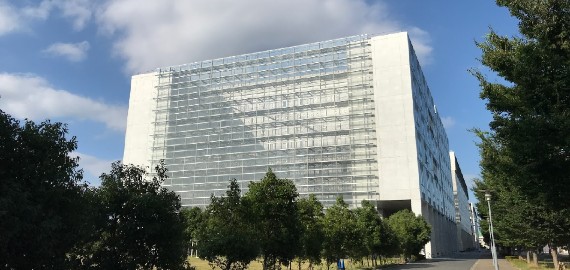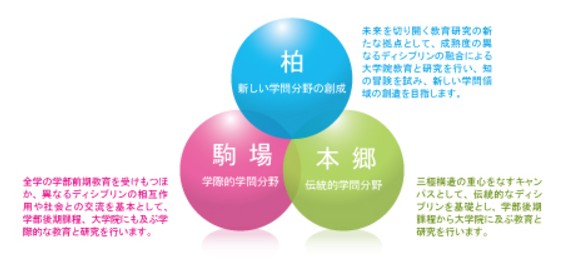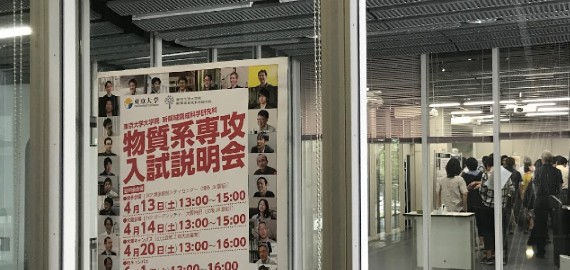
This major was established in April 1999 in the Graduate School of Emerging Areas, The University of Tokyo, and is a new 21st century graduate school that integrates materials and physical property related instructors such as the Institute for Solid State Physics, Graduate School of Science and Graduate School of Engineering. I am a major. This department is created by the cooperation of the Graduate School and The Institute for Solid State Physics, and pursues the role as the strongest and largest physical properties center in the world. There are many instructors who are aiming at physical properties, and they conduct research together with students, and also provide comprehensive and systematic wide-ranging physical education, and foster a true professional in physical properties research.
The "substance" we are dealing with is a super-multibody system in which nanoscale components of an atomic nucleus and an atom made of a plurality of electrons are assembled over an astronomical number of 1023. So far, various substances and various phenomena that they exhibit have been understood, and studies have been established to apply them. However, the degrees of freedom that we can handle at present are only a small fraction of the astronomical degrees of freedom that supermassive systems have. The goal of this major is to explore this untapped freedom, search for new phenomena, construct new concepts, and develop their application areas.

The target of research in the Department of Materials Science is a system in which as many as 1023 atoms and valence electrons are condensed in 1 cm³.
Many degrees of freedom, sometimes behave in a variety of ways, sometimes in strong solidarity, and with a little stimulus such as heat or pressure, are surprising and entertaining to undergo a flashy transformation.
Very importantly, this multi-degree-of-freedom solidarity through phase transitions is the source of technologies that support society, including LCD TVs, hard disks, and MRI.
By the way, our greatest pleasure is that students can gain great confidence and be as good as different people during the short period of time they are in this major, with some misunderstandings. ..
Why don't you make a phase transition in the material system major where fun and freedom are condensed?

The "matter" we are dealing with is a super-multisystem formed by the collection of astronomical numbers of 10 to the 23rd power, which are nanoscale components of atomic nuclei and atoms consisting of multiple electrons.
So far, research has been conducted to understand and apply various phenomena exhibited by various substances.
However, the degrees of freedom we are currently dealing with are only a small part of the astronomical degrees of freedom that supermultisystems have.
The goal of the material system major is to develop a stage = "new material" that can manipulate the undeveloped degree of freedom, to search for unknown phenomena created from that stage and to bring out excellent functions, and to bring out its excellent functions. The purpose is to contribute to the development of human society by elucidating the mechanisms and developing application fields for these phenomena and functions.
To achieve these goals, we will conduct research using the following three approaches.
Soft matter containing strongly correlated electronic materials, semiconductor superstructures, organic molecular materials, and biological materials with aperiodic hierarchical structures, which will be responsible for future electronics, photonics, and spintronics, as well as nanoclusters and solids / liquids. ・ We are opening up a new world of material science, targeting various substances with various constituent elements and aggregation modes, such as the interface created by gas.
This is a material science based on cutting-edge technologies such as scanning tunneling microscopes, high-resolution electron microscopes, quantum beams such as synchrotron radiation and neutron rays, ultra-short pulse lasers, and first-principles simulations using supercomputers. Do research.
Through these observations, it is expected that many-body effects in matter, including strong electron correlation, can be elucidated. Regarding this, we are constructing methods for generating and detecting various extreme states and non-equilibrium states, and the theory for understanding them.

In contrast to the Hongo Campus, which aims to inherit and develop its specialized fields, and the Komaba Campus, whose mission is interdisciplinary education and research, the Kashiwa Campus offers cross-disciplinary education that is retroactively reorganized based on existing specialized fields. We pursue research, that is, "adventure of knowledge".
By enriching the Kashiwa Campus as the third "pole" following Hongo and Komaba, the tripolar structure that the University of Tokyo is aiming for will be completed.

In the Department of Materials Science, we will explore the undeveloped degrees of freedom of materials that are composed of astronomical numbers of electrons and atomic nuclei and have various degrees of freedom, explore new phenomena, and build new views of matter. Promote research with the aim of developing these applications.
Through the practice of leading research at the frontier of material science and comprehensive and systematic wide-ranging physical education, we have a cross-disciplinary perspective and creative problem-solving ability based on advanced expertise, and next-generation society and science. To develop human resources who will lead the way. The Department of Materials Science consists of the three majors of the Graduate School of Engineering, "Physical Engineering", "Materials Engineering", and "Applied Chemistry", and the Institute for Solid State Physics participates as a cooperative course. It was newly established in April 1999 as one of the four majors in the Graduate School of Frontier Sciences, the University of Tokyo.
So far, I have been working as a new 21st century graduate school major at this Kashiwa campus.
Currently, in collaboration with RIKEN, Industrial Technology Research Institute, Material and Materials Research Organization, and SPring-8 (Large Photon Ring-8), it is based on physics, chemistry, materials science, applied physics, and applied chemistry. It has become the world's largest research center for integrated materials science and is practicing leading material science research.
In this fulfilling environment, we are conducting a new type of material science education based on academic fusion, aiming to develop researchers and engineers who can play an active role on the international stage in the future.
Let's learn and practice cutting-edge science and disseminate it to the world under the various elite professors of this major.
The goal of Applied Physics is to develop a stage = "new material" that can manipulate undeveloped degrees of freedom, to explore unknown phenomena created from that stage and to bring out excellent functions, and to bring out its excellent functions. The purpose is to contribute to the development of human society by elucidating the mechanisms and developing application fields for these phenomena and functions.
© 2021 Advanced Materials Science. All Rights Reserved